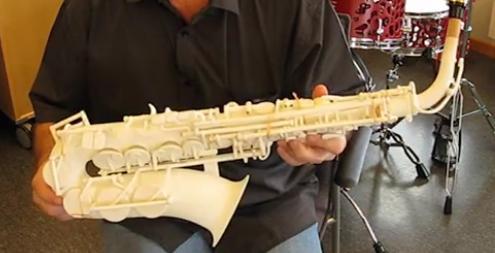If you have been following the music scene and have any interest what-so-ever in 3D printing, then it is very likely that you have seen the work of a man named Olaf Diegel. He has gained notoriety for his 3D printed guitars,  and drum sets, which have made their rounds at several 3D printing conventions over the last year. Olaf is the type of guy who enjoys the challenge of it all, so when he was challenged to 3D print a working saxophone, how could he say ‘no’? Especially when the challenge came from one of the leaders within the 3D printing industry.
and drum sets, which have made their rounds at several 3D printing conventions over the last year. Olaf is the type of guy who enjoys the challenge of it all, so when he was challenged to 3D print a working saxophone, how could he say ‘no’? Especially when the challenge came from one of the leaders within the 3D printing industry.
“I’ve been collaborating with 3D Systems on all my instruments, and this one originated from a challenge at last year’s Euromold tradeshow, where 3D Systems had a band on their stand playing my 3D printed instruments,” explained Diegel to 3DPrint.com. “Avi Reichental challenged me to add a sax to the orchestra, and who can say ‘no’ to a fun challenge like that?”
Diegel spent weeks designing, perfecting and then printing out the first ever 3D printed saxophone. He designed the entire thing in CAD software, Solidworks, by measuring the various parts of a traditional sax he had at home. Once designed he used a 3D Systems sPro 230 to print the entire thing in Duraform PA nylon powder. As you can see from the video at the bottom of this article, it not only looks amazing, but also plays quite well according to Diegel.
“Surprisingly to me, the sax sounds very much like a sax, only maybe a touch quieter. I have a traditional sax that I used to copy the various key spacings and they both sound pretty similar. There are injection molded plastic saxophones around on the market, so I guess a plastic sax is not unheard of. I suppose it’s the same progression as clarinets, which went from wood to bakelite (and some in metal) to plastic. Undoubtedly, there is a difference in sound between a plastic and a metal instrument, but it’s hard to say that one sounds worse, or better, than the other. My suspicion is that it has a lot more to do with the player than the instrument.”
Diegel isn’t done yet, however. He plans on making a second 3D printed saxophone, this time trying to perfect it, eliminating the rubber bands he had to use in the first version, by replacing them with parts which could be integrated into a more conplex design, via the capabilities of 3D printing.
“Mechanically, I will be integrating all the springs as a direct part of the keys,” explained Diegel in an email. “The current iteration uses traditional metal springs for all the keys, but those springs are designed to be hammered into the metal (to prevent them from spinning) which is something that cannot be done with plastic. If I get access to a multi-material printer, I might also give integrating the sax pads (which on a traditional sax are padded leather) directly into the keys.”
What Diegel could use, is something like 3D Systems’ ProJet® 5500X, a multi-material printer which can fabricate objects with a combination of rigid, flexible, and soft properties, all within a single print. Additionally Diegel plans on changing the look of the saxophone in order to take advantage of the complexity that 3D printers are capable of achieving.
“I’ll be doing major work on the aesthetic shape of it to take advantage of what 3D printing can do. Think of the current iteration as a prototype that was done mainly to get all the mechanical aspects of it right, so the next one I can go a bit wilder on the aesthetics. I’m thinking maybe a cornucopia type look, or maybe a rock & roll 3D flame job…”
Certainly we all will be awaiting the final iteration of Diegel’s saxophone. Who knows what will be next…. maybe a violin or harmonica? That may depend on what challenge Reichental decides to issue next. Let us know your thoughts on this incredible 3D printed instrument in the 3D printed Saxophone forum thread on 3DPB.com. Also be sure to check out the video of Diegel’s first version of his instrument below.
Subscribe to Our Email Newsletter
Stay up-to-date on all the latest news from the 3D printing industry and receive information and offers from third party vendors.
You May Also Like
Air Force Awards Fortius Metals $1.25M to Qualify 3D Printing Wire for Hypersonic Applications
AFWERX, part of the US Air Force Research Laboratory (AFRL), awarded a Direct-to-Phase II Small Business Innovation Research (SBIR) contract worth $1.25 million to Colorado’s Fortius Metals, to accelerate qualification...
US Air Force Awards JuggerBot $4M for Large-format Hybrid 3D Printing
Large-format 3D printer manufacturer JuggerBot has received a $4 million grant to develop a large format 3D printer, courtesy of the Under Secretary of Defense, Research and Engineering Manufacturing Technology...
Where Have All AM’s Unicorns Gone?
In the rapidly evolving world of 3D printing, startups valued at over a billion dollars, known as unicorns, once seemed as fantastical as the mythical creatures themselves. While a few...
How My Childhood Fascination with Planes Led to Investing in 3D Printing
My fascination with aerospace started young, and I started studying planes–identifying them in the sky and learning everything I could about how they work. Fast forward to my first week...

































